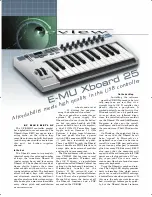
visualized place. All control knobs,
plus the wheels and pedal, have their
own edit sections, where they can be
named and assigned an initial value
(stored with the patch if you wish),
MIDI channel, and CC number.
You can choose up to 16 Program
Change messages to be broadcast when
a preset is called up, including Bank
Select MSB and LSB; this is handy
when working with softsynths that have
large numbers of programs and banks.
You can choose a velocity curve by sim-
ply clicking on the appropriate graphic.
You can also set parameters in
advance that aren’t active—for exam-
ple, you can have 16 Channel Mode
turned off but have its default con-
troller preset to the one you might want
to use, so one push of a button has you
set up and ready to go. Latch Mode and
its associated key range can be set here
too. When you have a set of parameters
ready, you can save it to hard disk as
one preset in a Bank, and/or transmit it
to the Xboard for immediate use.
We won’t speak in detail about the
two other programs (for Windows
only) included with the keyboard.
They are a ‘lite’ version of Ableton
Live, a program that needs no intro-
duction to our readers, and ProteusX
LE, a very solid and good-sounding
sample playback synth with a fair bit
of power, eminently suitable as a
beginner’s first virtual instrument.
They add a nice bit of value to an
already substantial package.
Minor gripes, major props
What are we missing? A MIDI In
port, so you wouldn’t need a separate
MIDI interface—but to be fair, most
beginning computer musicians won’t
have an immediate need to incorpo-
rate data from external MIDI devices,
so this is a good place to economize
and simplify. Another appropriate
corner-cut is not having faders on the
Xboard 49; good slider pots are
expensive and cheap slider pots can
be worse than useless, broadcasting
false data when they get dirty or
worn. The one thing we genuinely
miss was the ability to tweak the
aftertouch sensitivity beyond On or
Off... but having aftertouch at all on a
keyboard this affordable easily out-
weighs that gripe.
All in all, the Xboard offers a lot
more features than meets the eye—
and the software tools to use those
features easily and effectively. At this
price, you should treat yourself to a
product that’s several steps above its
bargain-basement competition in
build quality, feature set, and playing
satisfaction. Way to go, E-MU!
Prices:
Xboard 25, $199.99; Xboard
49, $229.99
More from:
E-MU Systems, Inc., 1500
Green Hills Rd., Scotts Valley, CA
95067. 831/438-1921 or 877/742-6084,
fax 831/438-8612, www.emu.com.
E - M U X b o a r d 2 5
RECORDING JANUARY 2006
60
(see below) makes programming the
Xboard a treat.
On occasions where you can’t or
don’t want to fire up the Xboard
Control program, you can edit all of
the Xboard’s settings from the front
panel, using keyboard keys to select
functions and the data slider to alter
them. This includes aftertouch on/off
(no selectable sensitivity or
curves, alas), velocity curve, semi-
tone transpose, MIDI Bank Select
and Program Change messages
sent when you call up a preset on
the Xboard, and much more.
Several buttons offer one-
touch access to critical functions.
The Knob Bypass button disables
the knobs and allows you to reset
them to where you want them
without sending jarring MIDI
messages. The 16 Channel button
switches the Xboard to 16
Channel Mode, where all the
knobs send the same CC number
(CC 7 for volume, CC 10 for pan,
etc.) on all 16 MIDI Channels.
This lets you quickly convert
your synth controller into a 16-
channel level mixer and back, for
example. You can send a snap-
shot of all current controller val-
ues via MIDI, or use the Latch
button to make the keyboard
“latch”, i.e. keys continue to
“play” if pressed and released,
and only stop if touched again. This is
useful for triggering loops, and can be
restricted to a small portion of the
keyboard, perhaps a very high or low
set of notes accessible only with the
Octave keys.
The keyboard itself has a solid feel,
not as snappy as lighter/flimsier
actions but very playable, and the
aftertouch sensing is wonderful for
playing synths that follow it. Our only
complaint is that the aftertouch is
overly sensitive, needing only a tiny
bit of key pressure to activate it.
Better than no aftertouch at all? Oh
yeah! [
E-MU reports that an upcoming
software upgrade will provide easy
adjustment of the aftertouch thresh-
old
.—MM]
Xboard Control
As you can see from the screen-
shot, Xboard Control gives you all the
features of the Xboard in one easily
The Xboard Control software (seen here on Mac OS X) offers complete
graphic control of the Xboard’s many MIDI message types.
REC mag 01-06 Final 11/23/05 11:07 AM Page 60


